Brief
Engineering Design Challenge
Building Life Skills Through STEM Experiential Learning
Connected Science Learning October-December 2018 (Volume 1, Issue 8)
By Mark Haugen, Margo Bowerman, R. Michael Compton, Anne Stevenson, and Patrick Jirik

Minnesota 4-H seeks to improve the quantity and quality of out-of-school STEM (science, technology, engineering, and math) experiences for middle school–age youth. In 2013 the Minnesota STEM team, a statewide team of 4-H staff charged with providing leadership for STEM programming, collaborated to create the Engineering Design Challenge (EDC) to engage youth across the state in a focused, Rube Goldberg–style challenge. The EDC has grown rapidly and attracted the interest of new program partners, volunteers, and youth learners.


The Engineering Design Challenge
During the EDC, youth work in teams of 3 to 10. This background video shows how youth collaborate to create a complex machine that performs a simple task and then demonstrate and communicate their learning to others in a public space. A new challenge task (e.g., plant a seed and water it) is determined each year with input from youth across Minnesota.
The EDC is designed to be a short-term commitment (two to six months) that invites new families into Minnesota 4-H. This STEM learning experience is accessible to sites with limited funding. The EDC also appeals to youth and families who may not have had opportunities to explore STEM-focused learning that uses the design cycle and the eight practices of science and engineering, as outlined in the Next Generation Science Standards (NGSS Lead States 2013). A multifaceted approach consisting of local recruitment events, youth and adult educational programs, and various staff supports is used to recruit youth and adults and support group learning experiences. The available support materials include a guidebook with rules, tip sheets, judge training, an evaluation rubric, and a curriculum to support youth decision-making and content-specific learning.
The EDC has offered many opportunities to bridge experiential, 4-H learning opportunities with school-based partners and afterschool programs. Introduced in 2014, the EDC was immediately popular with 125 youth participants and 22 teams. By 2016, 335 youth participated on 56 teams. Nearly one in five (19.6%) of these youth were first-year 4-H members. It is easy to replicate in settings, from school classrooms to museums and other youth-serving organizations. For example, an elementary classroom incorporated the challenge into its inventions unit.

The Engineering Design Challenge Curriculum
The Engineering Design Challenge Curriculum was developed to support the needs of educators and volunteers who lack STEM expertise but are interested in creating and leading EDC groups. The curriculum can also be used independently to support youth participation in public exhibitions or competitions hosted by partners. Through step-by-step instructions, nonformal educators can lead experiences and develop STEM skills.
The 38-page curriculum includes 12 45-minute lessons and the needed support documents. Each lesson includes a goal statement, clear objectives, a list of needed materials, activity steps, photo examples, and recommended reflection questions. The goals of the curriculum are to:
- create opportunities for youth to identify engineering problems, develop sound reasoning skills, and provide solutions backed by evidence;
- provide opportunities for oral youth presentations, explanations, and demonstrations of various STEM topics; and
- provide youth opportunities to exhibit a machine designed and developed by a team, to share their experience, and to celebrate their creation.
This curriculum supports Minnesota’s grade 9–12 science standards’ practice of Engineering, under the Nature of Science and Engineering strand. These activities also support the disciplinary core idea of Engineering Design in the NGSS. The intended program model for this curriculum is 12 45-minute sessions over one to three months. Eight lessons (1–8) can be used as stand-alone STEM educational experiences and the final four (9–12) prepare youth for a public exhibition.
You can download the curriculum for free, including the support resources, although you need to complete a brief survey to access the material.

Impact
EDC evaluation results show a majority of youth are learning the engineering design process, simple machines, energy transfer, teamwork, public speaking, and problem-solving skills. The EDC has also served to bring new adults into volunteer roles within 4-H. At public community events, such as county fairs and school science fairs, teams demonstrate their learning to STEM industry professionals, business leaders, and educational institution representatives. In addition, many teams have had the opportunity to showcase their learning and machines within the larger public venue of the Minnesota State Fair. Media outlets help tell the story of young people who are excited about engineering design. See a featured story about the program at the Minnesota State Fair.
Mark Haugen (hauge257@umn.edu) is an extension educator in the Center for Youth Development at the University of Minnesota Extension in St. Paul, Minnesota. Margo Bowerman (mbowerma@umn.edu) is an extension educator in the Center for Youth Development at the University of Minnesota Extension in St. Paul, Minnesota. R. Michael Compton (mcompton@umn.edu) is the science of agriculture and STEM director in the Center for Youth Development at the University of Minnesota Extension in St. Paul, Minnesota. Anne Stevenson (steve020@umn.edu) is an extension educator in the Center for Youth Development at the University of Minnesota Extension in St. Paul, Minnesota. Patrick Jirik (pjirik@umn.edu) is an extension educator in the Center for Youth Development at the University of Minnesota Extension in St. Paul, Minnesota.
Engineering Informal Education


